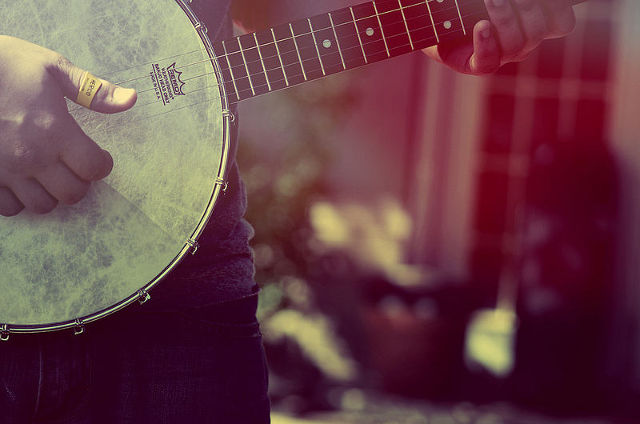The banjo is the greatest instrument of all time - a four, five, or six string instrument like a guitar, only better! It is popularly associated with bluegrass, country, and folk music styles. If you are new to the banjo, you should be ready for a fun experience with a very up-tempo and interesting instrument! Like any other musical instrument, it will take dedication and lots of practice. A good place to start is to learn the fundamental banjo chords and practice until you can do them perfectly. You can gradually learn more interesting and complex chords, but you have to start with the basics.
Begin by putting on your finger picks – one for your thumb, one for your first finger, and one for your second finger. The picks make it easier to single out individual strings, and give the banjo chords and notes a twangier sound. The easiest of all chords is the G chord – it is played by simply strumming all the strings with your right hand, without holding any down.
Now we have to learn a bit about the common way that people speak and write about playing banjo chords. You might already know by now that the strings are numbered, with the thinnest string being 1 and counting up from there. In addition, the fret of the banjo neck closest to the tuning knobs is numbered 1, the next is 2, and so on. The fingers are referred to as first finger, second finger, third finger, and fourth finger (index to pinky). These conventions are important to learn and remember, because in many cases banjo chords are described using these numbers.
The next chord to learn is C, which is one of the most common banjo chords. Begin by placing your first finger on the first fret of the second string of the banjo; then place your second finger on the fourth string on the second fret; then place your third finger on the second fret of the first string. This may sound complicated, but it is one of the simpler banjo chords and you will master it in no time. Again, strum the chords with your right hand. Practice making and playing this chord, then try switching back and forth from C to G.
For people without formal training in music theory, tablature (tabs) are the most common way to read and write banjo chords. Tabs usually consist of small diagrams of the banjo strings, with numbers on the strings representing the frets that you must hold down. Most chords are written this way, but sometimes the strings are left out and you will just see a vertical line of numbers. Other times, the numbers are just written horizontally. People who can read sheet music can understand banjo chords in terms of musical notation.
Learning a musical instrument can be tough and sometimes seems like a slow process. The key is to not give up! Practice whatever you already know until it's perfect, and keep pushing yourself to learn more. This is how all musicians learn to play. Search the internet for databases and listings of more banjo chords, and learn them all. Learn and practice whatever songs you are able to play. As you begin to get the hang of it, you can even start writing your own music!
Photo Credit:
TeeeJayy
Login to
Don't have an account?
Access Free
Access Free




